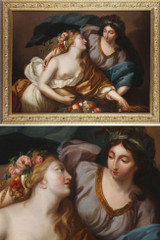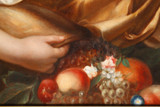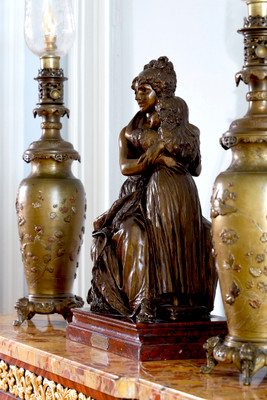Large canvas depicting "Peace Bringing Back Abundance" by a follower of Élisabeth-Louise Vigée Le Brun. A work of high quality executed towards the end of the 18th or the beginning of the 19th century, after the original work of 1780 held at the Louvre Museum. French School. Oil on canvas. Dimensions of the canvas (unframed): H: 98cm, W: 130cm. "Peace Bringing Back Abundance": reception piece for the Academy. Élisabeth-Louise Vigée Le Brun (1755-1842), admitted to the Academy thanks to the support of Queen Marie Antoinette (1774-1793), presented this painting upon her admission to the Royal Academy of Painting and Sculpture in 1783. The reception piece for the Academy is the work by which the applicant demonstrates their talent to their peers. The allegorical subject matter is linked to history painting, which was the most prestigious genre in the hierarchy established by the Academy and traditionally reserved for men. A woman within the Royal Academy of Painting and Sculpture: The presence of a woman within the Academy was quite unusual in the 17th and 18th centuries. Founded in 1648 by Louis XIV, the Royal Academy of Painting and Sculpture aimed to train the best artists in the kingdom. Its students and members were, in fact, exclusively men, with the exception of the admission of the Italian pastelist Rosalba Carriera (1675-1757) in 1720. In the society of the time, it was unthinkable for a woman to consider a professional artistic career. Drawing and painting were part of the education of girls from good families, but their practice remained confined to the private sphere. The admission of women to the Academy began to be considered from the mid-18th century onward, reflecting a shift in mentality. The first female artist admitted to the Academy was Marie-Thérèse Reboul (1728-1805) in 1757. Other admissions followed, notably that of Adélaïde Labille-Guiard (1749-1803) in 1783. However, the admission of women to the Academy remained exceptional. Élisabeth-Louise Vigée Le Brun: a fight for equality. It was in this context that Élisabeth Vigée Le Brun painted her allegorical work "Peace Bringing Back Abundance" in 1780. Peace, dressed in a brown tunic and a blue cloak, wears her traditional attributes: a laurel wreath and an olive branch. Abundance is a young blonde woman, her hair adorned with roses and draped in gold, holding ears of wheat beside her traditional horn filled with fruit. The choice of subject is symbolic, demonstrating to Élisabeth Vigée Le Brun not only her mastery of the noble historical genre but also her ability to rival her male counterparts on their own turf. Determined and highly talented, she made her mark, gained recognition for her work, and achieved true status as a painter. Her struggle aligns with an unprecedented movement, encouraged by Marie Antoinette's circle: the professional affirmation of young women painters determined to break free from the amateurism imposed upon them by the academic system. Her fight for emancipation and professional equality resonates with us today because it remains relevant. 18th century, Circa: 1790. Dimensions: W: 149cm, D: 12cm, H: 116cm. The painting has been relined with some minor restorations and a very beautiful giltwood frame.
- Reference :
- 2778
- Availability :
- Sold
- Width :
- 149 (cm)
- Height :
- 116 (cm)
- Depth :
- 12 (cm)
- Identify Exists:
- False












































